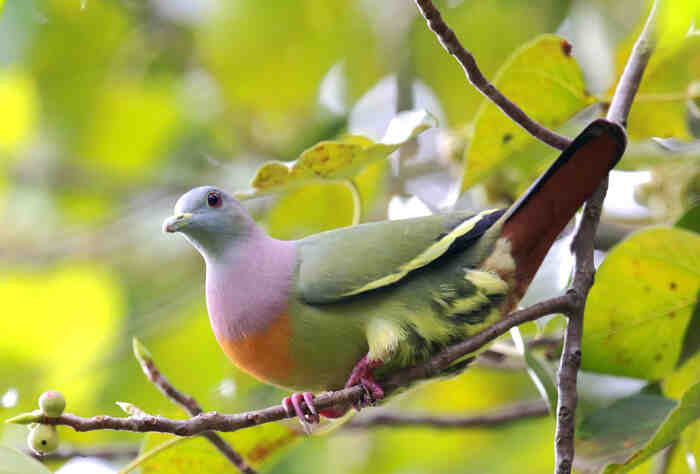Treron sphenura
IUCN
LCBasic Information
Scientific classification
- name:Treron sphenura
- Scientific Name:Green Pigeon,Treron sphenura,Wedge-tailed Green Pigeon
- Outline:Landfowl
- Family:Columbiformes Columbidae G.Pigeon
Vital signs
- length:28.4-34.9cm
- Weight:160-260g
- lifetime:10-16years
Feature
The tail is wedge-shaped, with the two outermost pairs of tail feathers having black subterminal spots.
Distribution and Habitat
The wedge-tailed green pigeon is distributed in Bangladesh, Bhutan, Cambodia, China, India, Indonesia, Lao People's Democratic Republic, Malaysia, Myanmar, Nepal, Pakistan, Thailand, and Vietnam.
It mainly inhabits mountain broad-leaved forests or mixed forests below 3,000 meters above sea level in China, including southwestern and central Sichuan, southern Tibet, western and southern Yunnan, northern Guangxi, and Shennongjia, Hubei.
Appearance
The wedge-tailed green pigeon is a medium-sized bird. The male has a bright yellow-green head and neck, with an orange-brown top. The back and shoulders are gray with a slight chestnut red tinge. The lower back to the tail coverts are dark green to olive green. The tail feathers are also significantly different from those of other green pigeons. They are wedge-shaped and longer. The central tail feathers are olive green, and the outer tail feathers are gray-green to gray-black. The outermost two pairs of tail feathers have a wide black sub-terminal spot and a narrow gray terminal spot. There are large purple-red chestnut spots on the wings. The chin and throat of the lower body are bright yellow-green, the chest is orange-yellow with a slight green tinge, the feather base is orange-pink, and the rest of the lower body is bright olive. The sides of the body, the undertail coverts, and the leg coverts are green-black with yellow feather tips or feather edges. The undertail coverts are ve
Details
Wedge-tailed Green Pigeon has four subspecies.

Wedge-tailed Green Pigeon is a resident bird, often moving alone, in pairs or in small groups. It is especially active in the morning and evening, mainly moving and foraging in the tree canopy. The call is very pleasant, full of flute-like sounds. It mainly feeds on fruits and seeds of trees and other plants. It mainly forages on trees and bushes. It often grabs overhanging twigs to eat wild fruits.
The breeding season of the wedge-tailed green pigeon is from April to July. The male bird's courtship behavior includes nodding, sticking out its chest, spreading its wings, spreading its tail, and jumping around the female bird, while making a "cooing" sound, and pretending to peck at the ground from time to time, and the female bird responds with the same action and call. It nests on tall trees in the forest. The nest is flat and very simple, made of only a small amount of dead branches. Each nest lays 2 eggs, and the eggs are white in color. The incubation period is 13-14 days. The chicks are late-maturing and can leave the nest after 12 days of care by the parents.
During the brooding period, pigeons secrete pigeon milk under the action of prolactin (also known as prolactin) secreted by the posterior pituitary gland. Pigeon milk is composed of fat particles, emulsified fat chylomicron and lymph fluid secreted by the proliferating flat epithelium of the bilateral lateral sac lymphatic area of female and male pigeons, that is, the crop bed lymphatic area. After the colostrum period, chylomicron rich in emulsified fat particles is gradually added. The epithelial lymph papilla of the crop bed generally begins to sprout on the 4th to 5th day of the incubation state. The crop bed of male and female pigeons begins to sprout, the blood vessels of the crop bed are congested and thickened, and the lymphatic vessels proliferate. By the 8th to 9th day, the crop epithelium thickens and enters the pre-brooding state. On the 13th day, its thickness and width have doubled. On the 14th-16th day, it can secrete transparent slightly yellow pigeon milk. On the 18th day, the crop can secrete throat milk. However, on the 7th day after the squab hatches, the amount of crop milk secretion begins to decrease, and the secretion stops on the 10th day. It continues to vomit until the chicks are about 2 weeks old, and the crop bed begins to shrink, and the secretion of pigeon milk gradually stops. The semi-finished chyme that is ground by the gizzard and returned from the glandular stomach is gradually mixed into the chyme, and then it becomes a granular feed mixed with water for direct feeding. If the incubated eggs fail to hatch on time, pigeons with good hatching performance can continue to incubate until the 22nd-24th day at most (these are all related to the incubation performance of the pigeon, the hatching season, the feedback of embryonic development information, the frequency of hatching of the chicks, etc. In the cold winter and spring and the brooding period, the incubation period will often be automatically extended, and it is often difficult to persist in the hot and humid days of summer). At this time, the brooding pigeons will automatically stop incubating with the shrinkage of the crop bed.
Listed in the "National List of Terrestrial Wildlife with Important Economic and Scientific Research Value" issued by the State Forestry Administration of China on August 1, 2000.
Listed in the 2013 Red List of Endangered Species of the World Conservation Union (IUCN) ver3.1-Least Concern (LC).
Listed in the second level of the "List of Wildlife under National Key Protection in China".
Protect wildlife and eliminate game.
Maintaining ecological balance is everyone's responsibility!








